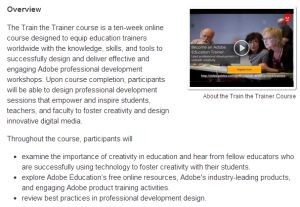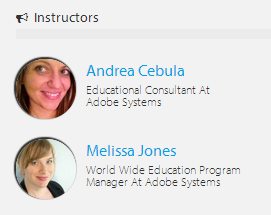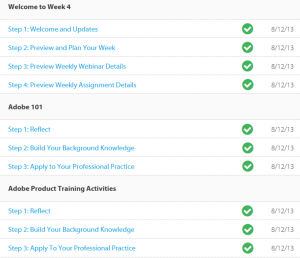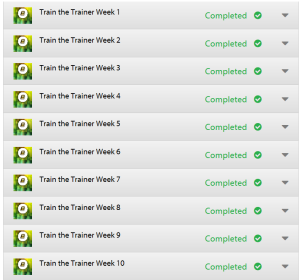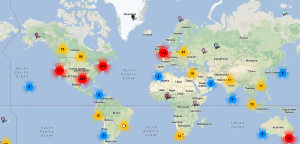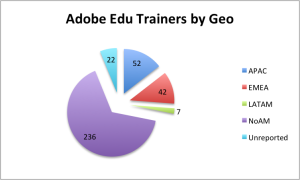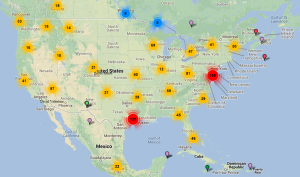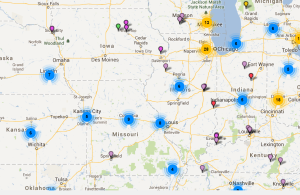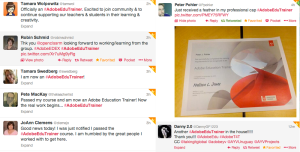I recently completed my first MOOC (Massive Open Online Course). This was created by Adobe and titled their Train the Trainer course. It ran from July 21 through October 21. By successfully completing this course, I have earned the designation Adobe Education Trainer. I have included that badge in the sidebar on the right. This course required roughly 75 hours of effort to complete over the 10 weeks. It was hosted on the Adobe Education Exchange. Since this was my first MOOC, I thought it would be appropriate to include my insights and thoughts. Many thanks to Melissa for also providing some extra information regarding the course.
The course itself is described in the overview below. you will need to click on the image to expand it in order to read all the information. Yes, that is yours truly in the background of the video.
The instructors for the course were Melissa Jones and Andrea Cebula (shown below).
The course focused on a number of Adobe products including Acrobat, Photoshop, and InDesign and stressed creativity and fundamental approaches to teaching these topics. I learned a lot during these 10 weeks. I particularly liked the sections on creativity in the classroom and adult learning best practices.
For those who have never experienced a MOOC, this is what happens during a typical week. We were presented with a topic overview on Sunday. We received a weekly schedule (below) and were expected to be active every day. Of course, we could work at our own pace.
The optional online webinar was held on Wednesday. We were expected to contribute the the discussion forum and to provide our assignments by the weekly deadline. We were then asked to review and comment on the assignments of others. We had to review at least 3 other assignments and rate them in order to complete that week. The overall pace of the course was fast and it was very important to keep up. I did miss most of one week (I was participating in the Adobe Education Leader Summer Institute in San Jose). It was a struggle to catch up the following week. We were able to record our progress every step of the way. For example, on a weekly basis, we could see what needed to be completed (and what we had already accomplished).
We could also see what we had accomplished in terms of each topic. At the conclusion of the course, I saw that everything was completed.
Having this visual feedback was a definite help to keep on track (after all I was doing a lot of other things during the summer and fall as well).
The course started with over 2,700 participants. Of those, over 1,600 posted their location on a map provided in thee course (below). You can click on the map to see the larger version. You will note that most regions around the world were represented. [Every continent except Antarctica.]
Melissa also provided this breakdown of participants who completed the course by region. [Again, many thanks Melissa for the extra information].
In terms of the United States, this was the distribution of students. Yes, I included Canada and Mexico in the screen capture.
In the Midwest, this was the distribution of students.
There were so many students from so many countries. We met once a week using Adobe Connect. This was the highlight of the class for me. I had the opportunity to discuss many topics with peers throughout the world. I participated in morning sessions (which allowed me to speak with those in Europe) and evening sessions (which allowed me to speak with those in Asia and Australia). I really looked forward to these weekly interactions. And… yes… while we live in different places and are part of different cultures, many of the issue I face in teaching technology are shared by everyone else.
The class started with 2,700. Of those, nearly 1,000 successfully completed week 1. As best I can tell, a little over 360 successfully completed the course. This would represent a 13% completion rate (which is higher than many MOOCs). Most MOOCs experience lots of attrition. I believe Coursera experiences a completion rate of 5-7%. I do realize the pace was intense, but I think the main reason people left was due to other work activities. I suspect having a few sessions coincide with the start of the fall semester for most of us was a big issue. 78% of the graduates were identified as educators; the remainder were staff or administrators). Adobe expects that these 360+ graduates will train over 30,000 educators in the coming years. So the impact of this course should be tremendous. Based on feedback I received from Melissa, 93% of course participants found th course valuable and 95% would recommend it to others.
Melissa shared the following breakdown of participants.
- 17% primary educators
- 44% secondary educators
- 41% post-secondary educators
- remainder were adult continuing education or other
It took Andrea and Melissa about 160 hours of effort to develop the course. Once the course was running, it took about 20 hours per week to moderate, administer, and address questions.
For those who are interested, I provide the final view of my project. Those who rated it viewed it very highly. [No I can’t add my own rating.] I also received a number of positive comments as to how thorough this project was. Those who have completed the CMWEB 280 class have been exposed to this material. It was great to have my efforts validated by peers.
If you would like to review the actual project, you will find it on the Adobe Education Exchange. You will need to be a member of the Education Exchange to download the files.
Was the MOOC worth it? YES. Ok, I was shouting. I found that it was very helpful to see how others teach various topics. It was great to interact with peers from around the world on a weekly basis. It was great to receive comments and validation from peers. I learned a lot (for example, the little planets exercise with Photoshop). To me, the interactions with others were the main benefit. I now also have access to many additional resources and materials that I would not have had access to. These should be helpful as I develop additional materials for my classes next semester.
Those who passed the course are members of the Adobe Education Trainer group on the Adobe Education Exchange. To maintain membership in this group, members must deliver 4 in person or 1 online training session in the next year. You can follow the group using the hashtag #AdobeEduTrainer on Twitter.
I believe the MOOC will be offered again in January or February, 2014 and I encourage anyone interested in developing their skills in teaching Adobe products or learning the latest best practices in delivering education to others to sign up and take the course. I would definitely be interested in your comments as well.
